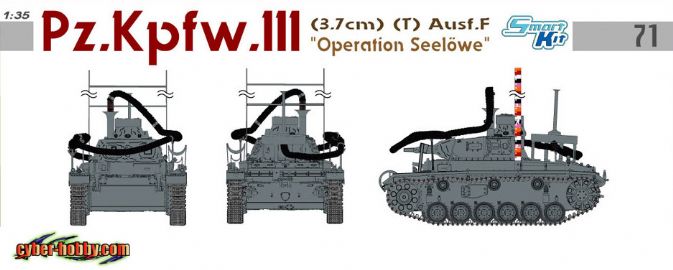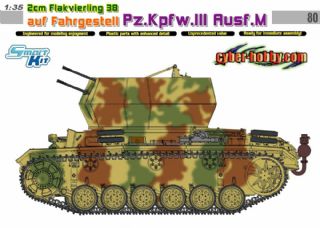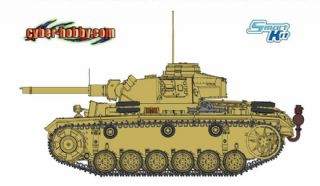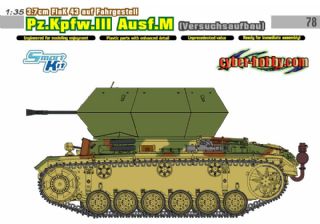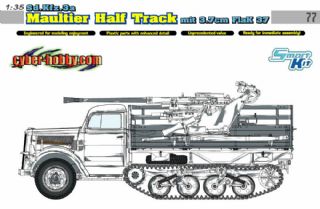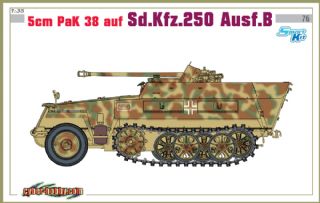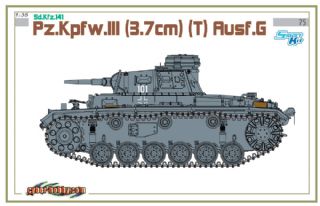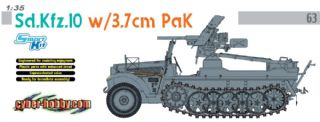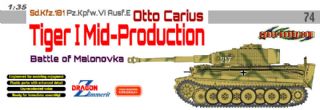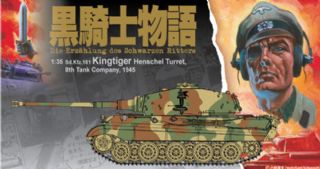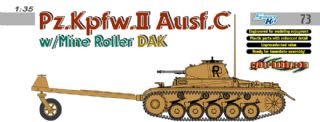HOME → Cyber-Hobby Plastic Model Kits & Collectibles → Cyber Hobby Exclusives → Cyber Hobby Exclusive Model Kits → 6717
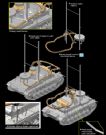






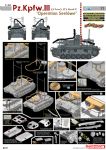
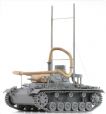
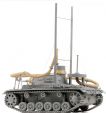
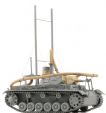



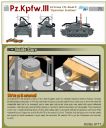
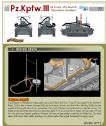
Review>
Kit, Cyberhobby 6717, Pz.Kpfw.III (3.7cm) (T) Ausf.F Operation Seelowe
CYBERHOBBY
6717, Pz.Kpfw.III (3.7cm) (T) Ausf.F Operation Seelowe Smart Kit. 1/35th-scale injection-molded styrene/multimedia kit. Contains: 574 styrene parts (including 25 clear), two bags of individual-link Magic Tracks, one photo-etched brass fret, three DS100 parts, six pieces of formed metal wire, one water-slide decal/marking scheme and six pages of instructions in 17 steps
Introduction.
The English Channel has historically been the moat which protected Great Britain from most large-scale invasions. In the 20th-century, it presented a major obstacle to Hitlers German war machine, one which eventually was not to be overcome. As part of the initial planning for the invasion, various Panzerkampfwagen were modified and tested for submerged or floating operation. The Pz.Kpfw.II was fitted with pontoons to swim across. The Pz.Kpfw.III and Pz.Kpfw.IV were to be lowered onto the sea-bed close in-shore and would crawl up onto the beach. The latter Panzer were termed Tauchpanzer and Cyberhobby has now added 77 new parts to create one of the two versions of the Pz.Kpfw.III that was tested in early 1940. These are mostly conventional styrene (some clear) with the exception of three in DS100 flexible styrene and four pieces of metal rod. Note that this was an Ausf.F armed with the 3.7cm KwK, but it cannot be built as the standard tank due to the lack of certain critical parts. The modeler should consider this kit if he wishes only to build the Tauchpanzer.
Tracks.
These come loosely packed in two bags and are so-called Magic Tracks. They represent the Kgs.6111/380/120 38cm-wide links that had hollow guide horns and plain cleat faces. These tracks are also handed, so the modeler is cautioned not to open up the bags and mix things up prior to assembly; as an added bit of help, each sides links are a slightly different color of gray styrene. Being Magic Tracks, they have no sprue attachment points, which is a definite time saver since no cutting or clean-up in that regard is required. Each has a pair of extremely faint ejector pin marks on the inner face. These can be ignored or erased as the modeler sees fit. They fit together easily but quite loosely, and must be fixed together with glue prior to handling.
Suspension System.
The road-wheels are conventionally molded in inner and outer pieces, with integral rubber tires. These are the same road-wheels from all previous StuG.III/Pz.Kpfw.III kits and properly represent the type with 95mm-wide tires seen on later and refurbished Ausf.Fs.
The outer faces of the wheel hubs feature perforations and weld beads where appropriate, while the tires have a facsimile of the manufacturers logo (ContinentaU) on their rims. On the inner faces, the tubes that helped join the wheel halves together are molded on, providing an unprecedented level of detail in this regard. Spare road wheels and spare track pins are also given for stowage. The return rollers are conventionally-molded in two parts (inner and outer halves). This kit has a pair of separate return roller mounts; these will allow the modeler to place the mounts in their original locations, or further forward as later modified (and seen on this particular version).
The drive sprockets come as conventional inner and outer pieces and are completely detailed; they are the type initially used for the 38cm tracks. The idler wheels are also in inner and outer parts, but feature separate hubs as well as etched brass inner rings. The idler wheels also have separate cranked axles that can be very slightly adjusted; the modeler is advised not to glue them in place on the hull until the fit and sag of the tracks have been worked out.
Separate internal torsion bars are given as are beautifully-detailed separate external swing arms. This will allow the suspension to be fixed in an articulated fashion if the modeler desires to place his work on a base with irregular terrain. To do so, simply cut off the pins that protrude from the hull sides, which are there in case the modeler wants a level, fixed suspension. Slide-molded shock absorbers with rubber boots on the top are given as well as properly-configured mounting plates for the final drive housings. Other separate parts include the final drive housings and bump stops.
Hull and Fittings.
The main part of the hull is based upon the 5.Serie/Z.W. Panzerwanne (armor hull); as such, it includes the side-wall escape hatches as separate multi-part assemblies that can be depicted opened or closed. Also seen is the simple all-bolted angle-iron hull/superstructure connecting strip. The hull is produced from a slide-mold so it is fully detailed on all faces. This detail includes mounts for the road-wheel torsion bar/swing arm units, idler wheel mount, bump stops and shock absorber mounts, as well as the various bolted strips that connected the hull to the superstructure. Panel seams and weld beads are also present. The belly has drain plug and access plate detail molded in place, plus bolts and rivet heads, as well as weld beads, where necessary. A separate circular access cap as seen on this version of the hull is provided, while the modeler is also instructed to remove some bolt detail where appropriate.
The bow plate is separate and its configuration represents the base armor of 30mm as seen on the Pz.Kpfw.III Ausf.E. The glacis plate assembly includes the openings for the Einsteigklappen (driver and radio operators hatches), which are finished off with separate lids that include etched bras detail parts. The main glacis part incorporates fine molded-on hinge and weld details. The Entluftungsstutzen (brake vent armor hood) assemblies are representative of the type associated with this hull. The glacis plate has to be opened up from the inside to fit these parts. Next, three-part Anhangegabel (tow eye) assemblies are installed, as are a pair of head-lamps with separate, slotted front covers; the latter are complimented by pre-formed steel wire parts that well-represent the power conduits. New styrene parts are provided to replicate the guards that kept the cables that lifted the Tauchpanzer from the mother ship, into the water, from damaging the head-lamps.
The rear hull plate includes molded-on mounts for the rear towing eyes; the latter are composed of three parts for each unit. A separate dome-shaped access plate is fitted low on the center of the plate. A separate intermediary-angled plate connects the rear wall of the hull to the belly plate; it includes weld and access port details molded in place. New for this kit are a pair of three-part exhaust pipes with Ruckschlagventile (non-return valves); the standard mufflers with their exhaust pipes were dispensed with. Another new part seals-off the overhang below the Heckpanzer (rear armor) module.
Track-Guards and Fittings
The track-guards are detailed on the top and bottom surfaces; neither is marred by ejector pin marks. The well-rendered dot-pattern non-skid plates are complimented at one point with an etched brass part that continues the pattern at a right angle where it surrounds the engine cooling air inlet armored cowl. A number of separate parts go to make up the fillets where the track-guards met the hull; up front this includes etched brass parts. Separate mounting brackets and stiffeners are then added. There are two different rear mud-flap configurations provided; these will allow them to be raised or lowered without any accuracy or detail compromises. They are complimented by etched brass or styrene detail parts; the port-side assembly features the cut-out for the Abstandsrucklicht (distance-keeping tail-lamp), while the starboard side has an opening for the brake lamp. Separate Seitenluchte (marker lamps) in two styles of styrene (clear or solid) are also provided.
The tools are all separate parts, each of which features nice molded-on clasp and bracket details. Two multi-part tool boxes are provided, one for each track-guard; a five-part jack, a two-part, slide-molded jack block and a one-piece fire extinguisher finish the fittings.
The track-guards are now fitted out with a number of stanchions to hold the flexible breathing hose in its stowed position; partially-molded holes on the bottom must be drilled out. There are three on the starboard side and one on the port side; each is composed of two parts. The flexible hose is made from DS100 soft styrene and is well detailed. It has a mold seam which will need attention; I have found in the past that brushing liquid styrene cement over these kinds of seams helps to paint them away. Each stanchion is connected to the hose (when it is in the stowed position) with two-part styrene clamps. The port-side also gets a pair of multi-part brackets whose purpose is un-clear to me.
The final Tauchpanzer-related parts in this area go to make up a depth-measurement device. This is composed of two pieces of flat styrene, one on each track-guard. These have styrene cross-braces and metal rod supports which brace them against the superstructure side plates. Each is uniquely-marked in 100-centimeter increments, each of which is colored red, white, black, purple and orange. Single-meter measurements are represented in white and are numbered two through six.
Superstructure.
On the Pz.Kpfw.III, the Bugpanzer (front armor), and the Heckpanzer (rear armor) combined to create the Panzerkastenoberteil (armored superstructure). DML provides these as separate modules, reflecting how the actual Panzer was manufactured.
The Bugpanzer module consists of a core molding upon which is placed various panels for all-around detail fidelity. The separate roof panel features a turret ring with a properly-detailed race, devoid of the usual openings to bayonet-mount the turret. I prefer this, but this means the turret will not be especially secure on the finished model. The turret ring base shot deflector is also a separate part.
Separate side and front superstructure panels are then fitted. These feature separate, multi-part Sehklappen (view-ports), which include clear parts for the vision blocks; naturally they can be modeled opened or closed. Additionally, the starboard side features a rod antenna and its mount, while the associated two-part stowage trough, complete with wood-grain effect is mounted above the starboard side track-guard.
The 30mm thick superstructure front plate has the two openings for the drivers K.F.F.2 binocular periscope in place. The Fahrersehklappe 30 (drivers view-port for 30mm armor) is comprised of three parts externally to include either a styrene or etched brass rain-guard. The latter is provided with a styrene former attached to the V sprue for ease in obtaining the proper shape. The view-port is covered by a new part as part of the deep-wading system. The radio operators MG34 is not provided due to the inclusion of a two-part deep-wading seal; this is composed of one solid and one clear styrene part.
The Heckpanzer (rear armor) module is a separate part and is configured much like the original; the entire assembly can be left off to depict an engine change. Coming from a slide mold, it has details on all faces including various styles of plate and weld detail as well as attachment flanges and bolt heads. The four hatch lids are separate parts, with proper coaming detail around the hatch openings, and separate hinges.
Separate parts for the Heckpanzers lifting hooks are also given for maximum detail fidelity. An all-styrene tow cable is provided for the engine deck, but Id have preferred the option of a wound wire/etched brass/styrene option for better detail and flexibility. The modeler can go that route with an after-market set if so desired, as DML also provides alternate empty mounting brackets. Engine cooling air intake vents are provided; these include etched brass screens, but they are covered with styrene sealing panels and are best retained as spare parts. The multi-part rear section properly represents the configuration seen on the Ausf.F, to include a separate Verschlussklappe fur Andrehkurbel lid, with the hinge on the bottom.
There were at least two configurations of the Tauchpanzer, one of which had the air hose connected to the engine deck. The other had it connected through the turrets signal port opening, and this is how this kit is configured. Therefore, what is described as a hockey-puck-shaped balsa-wood buoy, topped by a thin breathing tube is provided. The 15-meter-long air hose ran from the turret and entered through the bottom of the buoy. The entire assembly consists of seven parts, to include separate L-shaped rests for when the device was stowed on the Heckpanzer module. However, according to photos in reference 4, there should be a semi-hemispherical cap over the buoys breathing tube, topped by a standard flexible rubber base and a 2-meter rod antenna. This is not provided in the kit.
Turret.
The upper shell is a one-piece affair, created from a slide mold, and is also new for this kit. It matches drawings in Reference 1, page 3-2-31, and is identified as a 5./Z.W. Turm mit 3.7cm KwK. The molded-on detail is crisp and complete, including counter-sunk screw head details, weld beads and signal-port splash guards/openings. Certain screw heads are filled in for this version and it should be noted that other patterns are seen on variations of this turret, which suggests a later version with 5cm gun is in the works. The signal-port openings each gets a separate Signalklappen (signal port flap), with the one on the starboard side having a Tarnklappe (fake periscope cover). An etched brass or styrene commanders blade sight can be fitted to the roof as well as a pair of grab-handles above each side-wall hatch. The Signalklappen on the starboard side of the turret is where the flared air intake tube is now fitted, while up forward on the turret roof, a new plate helps seal the mantlet from above.
The side walls of the turret include openings for the separate vision port flaps; these include interior hinges and clear styrene parts to represent the glass vision blocks. Separate splash-guards are then fitted in front of each of these assemblies, using location-assisting dimensions provided in the instructions. The side walls have openings that are complimented by multi-part hatch door lids. These are the two-piece type and they feature clear styrene for the vision ports armored glass, plus a new lid for one-half of each hatch opening. Separate hinges and separate coamings complete these assemblies. Other openings on the side walls receive detail parts such as lift hooks and door latches. The rear wall incorporates openings to mount a pair of separate MP-Stopfen (pistol ports), as well as proper model-specific rivet details. The separate turret base has a gear pattern on the ring race and a commanders seat. A new part is also provided to seal the turret base for deep-wading.
The Kommandantenkuppel (commanders cupola) represents the type with part number 021 B 9261, as seen on page 3-2-33 in Reference 1. Featuring the two-piece hatch lid and ring as a conventional styrene part, it can only be modeled in the closed position. It is then surrounded by a DS100 part that represents the water-proof cover. The cover, in turn, is fitted with five clear styrene parts to represent the windows that the commander used for external viewing. The entire assembly is complimented by a separate splash ring for the base of the cupola, on the turrets rear face.
The front plate is based on the 5./Z.W. Turm (turret) with a 30mm internal Walzenblende (gun mantle). This is covered with another DS100 part that represents the frame and water-proof canvas cover. This is further embellished by two clear styrene parts for the view-ports as well as a conventional styrene part representing a covered 3.7cm KwK. All of the parts used to depict the entire armament package are present in this box; they can go into the spares bin.
Molding, Fit and Engineering.
Like many of their recent new-tool kits, DMLs designers have gone to great lengths to provide a level of detail on the styrene parts not often previously seen. Slide-molds have been used in a very intelligent way either to allow for better detail rendition, or for ease of assembly. In other areas, multiple parts make up assemblies that require this approach. DS100 soft styrene has also been well-used; the only challenge will be the removal of the mold seam along its entire length. This can be painted away using liquid styrene cement as I have found to be the case with other DS100 parts. However, care and patience will be needed. On visible surfaces, not a single ejector pin mark was found and there was no shrinkage of any kind. Fit of major parts was excellent and mold seams were faint and easily dealt with.
Accuracy.
Where I could match the kits components and dimensions against reliable scale drawings from Reference 1 and 2, below, I found no discrepancies of any import. Physical details compare well with available photographs, with the exception of the omitted radio antenna mast and base, as noted above.
Decals and Markings Information.
The decals are the usual excellent Italian product from Cartograf. They are crisp, in register and have thin, closely-cropped carrier film. Markings for one Tauchpanzer are given as described above; there are also several white-outline Balkenkreuze national insignia provided. These are not visible in any of the photos seen in references 2 and 4, below.
Instructions.
These are in the usual drawn style and appear to be well-done. As usual, they are busy, and there are many steps within steps. Modelers are cautioned to proceed with care, especially when considering which physical options may go with a particular markings scheme.
Conclusion.
This is a very unusual variant of the Tauchpanzer, which, although it did not service in this specific configuration, will still make for a very interesting display piece. It is beautifully-molded and with the exception of the single omission mentioned above, is quite accurate. Those modelers who wish to have a well-rounded Pz.Kpfw.III collection would do well to consider this kit.
- Frank V. De Sisto
CH6717: Pz.Kpfw.III (3.7cm (T) Ausf.F 'Operation Seelowe'
1/35 injection plastic kit with multimedia accessories and decals
As part of the preparations for the Operation Seelowe (Sealion), the planned
invasion of Britain, 168 Panzer III were converted to Tauchpanzer. These watertight
tanks had additional seals, and tubes for exchanging air. They were to be launched
from vessels off the British coast, and then crawl along the seabed to reach
the beach. As Operation Sealowe was abandoned, they were modified and deployed
on the Eastern Front..
A series of photos from mid 1940 shows early production Panzer III Ausf F undergoing
submersion tests in Germany. One distinctive feature during testing was the
fitting of tall poles as depth markers to the tanks. These markers had coloured
bands at 10cm spacing and went to a depth of 6.3m. At this stage the Tauchpanzer
had an 18m flexible tube with a floating air intake to support deep wading on
the sea bed; this was later replaced by snorkels when it was realised that any
future use would be in the rivers of continental Europe.
This Cyber-hobby kit is a limited edition release of a Panzer III Tauchpanzer
as seen in the photos from the submersion trials in Germany (when fitted with
the depth markers), and as intended for use in Operation Seelowe (no depth markers).
It is an early production Ausf F with the 3.7cm tank gun.
This is the first Smart Kit release of a Tauchpanzer III. The previous Dragon
Tauchpanzer III was and Ausf H, which was released in the mid 90s and depicted
the tank after being reconfigured for operations within continental Europe (i.e.
as used to cross the River Bug). Dragon recently released two up to date versions
of the Tauchpanzer IV (eg kit 6327: Ausf. D and DR6402: Pz.Kpfw.IV Ausf.E Tauchpanzer
w/Betriebsstoffanhanger).
NEW PARTS FOR TAUCHPANZER III
This kit has new tooling for the depth markers and the Tauchpanzer specific
fittings. The fittings sealed off the gaps in the Panzer and enabled the exchange
of air with the surface. These include a fixed pipes and flexible tubing (made
from Dragon styrene) for receiving fresh air and expelling engine combustion,
the air intake stack with its buoy which was stored on the engine deck, modifications
to the rear hull where the muffler is replaced by non-return valves, a frame
and brackets to support the tubing.. Thin metal rods are provided in the kit
for the stays which supported the depth markers.
Also included are the waterproof tarpaulin covers around the mantlet and commander's
cupola which are made from soft Dragon styrene, as well as the sealing frame
for the turret base (plastic) and seals/covers for the driver’s visor and MGs.
The 37mm KwK gun has a new part which depicts the tarpaulin forward of a strap
(which hides the join) and the muzzle end of the barrel. Two new metal arms
are attached to the front which photos show were used to help lower the tank
into the sea.
OVERVIEW OF AUSF F
The underlying tank is based on the recent Dragon release Pz.Kpfw. III Ausf.
F (Smart Kit - number 6632). This early production Ausf F was produced in first
half of 1940. Indicative features are a vision port on the hull side for the
radio operator (not fitted to some initial production tanks), turret ring guard
on the upper hull and retention of the 37mm tank gun. Given this kit is well
regarded for its accuracy and fit of parts this kit should also be rewarding
to make.
Photo etch is provided for the air intake grills, upper fender supports (angled plate), commander sight, bracket for the fire extinguisher, centres for the idler wheels (early pattern idler), detail on the rear convoy light and parts of the rear fender flaps. A thin visor above the driver vision port is made from PE and is bent to shape using a guide built into one of the sprues (as the angle is less than 90 degrees this is useful).
TURRET
The turret has the numerous distinguishing features of early production Panzer
IIIs and is based around a 3-directional slide molded shell. Features include
the twin MG34s, early style "drum" commander's cupola, and the 37mm
KwK. The hatches and ports have internal detail and can be modelled open. The
toothed turret ring is integrated with the turret's base and like other Smart
Kit Panzer III there are numerous small parts for the various attachments to
the turret exterior. Due to the new Tauchpanzer mantlet, this release does not
instruct you to fit the gun breech.
LOWER HULL
The lower hull is based on a one piece tub typical of Smart Kit Panzer IIIs. Being an Ausf F, it has side escape hatches which on this kit are separate pieces with separate hinges that fit over open cut outs in the hull side. The lower hull is well detailed featuring items such as weld seams, drain plugs on the bottom, while most of the bump stops, and the shock absorbers on the sides are integrated into the one piece hull tub.
The suspension arms are separate parts. The rear idlers have photo-etched rims and feature the oval shaped lightening holes and raised ribs. The road wheels have the tyre and rim as one piece and are the rubber tyres depict the 95mm wide profile (the first Ausf F had slightly narrower 75mm tyres).
The rear hull has Tauchpanzer modifications. The muffler has been replaced by non-return valves and the smoke candle racks deleted (would not work when wet).
The tracks are Magic Tracks where each link comes loose, and for most modelers
require no clean up. They are the earlier 38cm wide type with open guide horns
and no chevrons on the outer faces.
UPPER HULL & ENGINE DECK
The Tauchpanzer's floating air intake is stored on the engine deck. The intake
was a 1.5m metal tube attached to a buoy so it would float. This was attached
to the flexible tube which feed the air into an inlet on the Panzer's turret
roof. The intake was stored on a metal frame attached to the engine deck above
the hatches.
The engine deck is similar to other Smart Kit Panzer III. It is based on a slide
molded frame with numerous smaller fittings being sharply tooled separate parts.
PE is provided for the screens over each side air intake.
The frontal armour is accurate with a separate bow plate for the 30mm thick
plates used on new build Ausf F. The air vent cowling on the brake access hatches
have plugs built in to stop water ingress. The front driving lamps have extra
metal hoops in front of them which are secured to the towing points and were
used to aid cranes when lifting the tanks.
DECALS
The new decal sheet is based on photos from the water tests in Germany including
near the Putlos training centre on the Baltic Coast. It contains the coloured
bands on the depth markers to indicate the depth. The decals include the numbers
and letters inside each 10cm band. The test Tauchpanzer were painted solid grey.
Also included are four spare Balkan Crosses.
RECOMMENDATION
The Cyber-Hobby Tauchpanzer is the first 1/35 release of a Tauchpanzer III as configured for Operation Seelowe and the submersion testing in Germany. The kit is accurate to photos and has crisp modern tooling. This is one of my favourite recent releases, and it should make a very interesting model out of the box. Highly recommended.
- Neville Lord
Pz.Kpfw.III "Operation Seelowe"
Manufacturer: Cyber-Hobby
Scale: 1/35
Material: Styrene
Serial Number: 6717
Price: TBA
Introduction
In preparation for the planned invasion of England (Operation Seelowe) following the Fall of France, a number of tanks, including 168 Pz.Kpfw. III Ausf. F, G & H were converted to Tauchpanzer (Diving tanks) between June and October 1940.
All openings on the vehicle were sealed with rubber, fabrics and tar while the
engine intakes were covered with rubber water tight seals and the exhaust stacks
operated with non-return valves. An inflatable rubber seal tightened the turret
ring while the mantlet, MG mount and commander's cupola were made water tight
with rubber covers. A special line charge was fitted to the rubber seals which
were used to blow off the covers once the tank was on dry ground. Engine cooling
was provided by sea water during the underwater drive at a maximum depth of
15m. An 8m flexible hose with a buoy at the distal end provided air for the
crew and engine. A gyroscope and radio communication aided direction.
Initial trials took place in August 1940 near Emden, a seaport in N.W. Germany.
Further trials were carried out in the autumn of 1940 and a landing operation
was carried out using a converted gun boat "Viper" and the small freighter
'Hans Herbert', both of which were fitted with a special ramp.
Although the landing trials worked well, the cancellation of Operation Seelowe
saw the Tauchpanzers being moved to a training area near Milowitz in 1941 where
the vehicles were modified with a steel snorkel after which further diving exercises
were carried out.
Tauchpanzers of 2./Panzerregiment 18 crossed the river Bug in deep wading operation
at the start of Barbarossa.
The Kit
For those who have built any of Dragon's recent Pz. III variants, the contents of this box will not come as a huge surprise. For those who haven’t, they are in for a real treat.
As we've come to expect from Cyber-Hobby, the box is literally crammed full
of plastic with 7 large sprues, six medium, seven small and three in transparent
styrene. You also have a lower hull, turret shell, preformed wires, two packs
of magic track links, a PE fret, decals and several parts formed with the now
familiar flexible DS100 Vinyl (Dragon Styrene).
Most of these contents are identical to previous Pz. III kits which is not surprising
as this is based on the same vehicle. The main difference being the addition
of the DS100 vinyl and other styrene parts for the snorkel and watertight parts.
Some sprues are also marked StuG III and Pz IV which shows how much in common
these tanks had with each other. The biggest additions are the inclusion of
new sprue Q of which there are three, DS sprue W, the DS snorkel tube and depth
marker rigging wires.
As with previous Pz III kits, building begins with the lower hull and running gear. The torsion bars are nicely done and allows the builder to articulate the suspension if required. It’s wise to pay particular attention to the instructions at this stage as it could be very easy to get the parts the wrong way round!
Special mention should be made to the front and rear suspension units. As Vinnie
has previously mentioned, they are a real work of art! Drive sprockets with
nice bolt detail are up front with correct early type idlers follow up on the
rear with PE rings to further enhance detail. Early type 75mm width road wheels
are included along with the correct 36cm tracks.
Crew hatches on each side of the hull are included as separate items but there
is no hull interior detail to show off if you pose these open. The hatches themselves
are detailed internally though.
Moving onto the rear plates, the standard early Pz III exhausts are omitted
in favour of a modified pair with one way valves.
The fenders are typical Cyber-Hobby with nicely detailed tread pattern on both
sides. And it’s here that I feel Cyber-Hobby have missed an important detail.
While the instructions show the OVM tools etc as optional, there are no clamps
provided if you wish to leave the tools off. And most pictures I’ve seen of
this tank show it without the tools being fitted. So if you want to depict this
‘correctly’, you’ll need to source your own tool brackets/clamps. However, if
you don’t, then the tools do have nicely moulded clamps on them - though they
could do with being thinned out a little for better realism.
The engine deck is supplied as a one piece affair with separate access/cooling
covers along with PE intake covers. Instructions show the fitting of a tow cable
on the rear deck with an alternative provision for IM clamps if you wish to
leave it off. Though I feel that PE clamps would be a better option if you can
source them?
The front end sees the addition of armoured brake intake covers with seals along
with lights and the expected 2 piece transmission access covers. The upper side
panels have separate vision ports which can be posed open if you wish. As mentioned
before, Magic Tracks are provided as standard with the usual light and dark
grey parts to easily identify which side they are fitted. The upper hull sections
fit together along with the fenders to complete the first 13 stages of the build.
A nice tough is the pre-formed wire for the side lights.
No detailed gun on this kit (even though the parts are included on sprue D)
but the turret is perfectly detailed as you’d expect. Here we see the addition
of the extra parts such as commander's cupola and mantlet cover moulded in Dragon’s
light beige DS100 vinyl material. While the side vision ports can be opened
and come complete with glass blocks, the commander's cupola is moulded in one
piece so the hatch is shut. Makes life extremely difficult if you want to place
a figure in the hatch! Saying that, the rest of the details are well rendered
and you also get the inclusion of an injection moulded inflatable rubber seal
for the turret ring base.
The last two steps of assembly show the fitment of the DS100 vinyl snorkel tube and the two depth markers.
You only get the choice of one scheme here. Panzer Grey with no national markings.
There are four included on the decal sheet though. However, a nice splash of
colour is provided with the decals for the depth markers.
Conclusion
For me, this is a must have kit. And while the box art wasn't greatly inspiring, the built up photos certainly are and this builds into something that will definitely stand out from the norm. As far as I can tell, this is the first ever model of this version of the Pz. III and Cyber-Hobby should be applauded for tackling this interesting subject. No doubt this will appear on many a modeller’s shelf and I’ll bet there will also be many a diorama of one parked on a dock side too. Highly recommended.
- Vinnie Branigan
Kit Review: cyber-hobby.com 1/35 scale Kit No. 71 (Dragon Models Limited 1/35 Scale '39-'45 Series Kit No. 6717); Pz.Kpfw. III (3.7 cm) Ausf. F "Operation Seeloewe" - Smart Kit; 854 parts (578 in grey styrene, 216 “Magic Track” links, 26 etched brass, 25 clear styrene, 4 steel wire, 3 DS Plastic, 2 pre-bent steel wire); pre-order price US$77.95 via Dragon USA Online
Advantages: unique variant of early model Pzkw. III; use of DS Plastic hoses permits either stowed or “in action” poses
Disadvantages: kit does not come with DS tracks, which will disappoint a few modelers
Rating: Highly Recommended
Recommendation: for all WWII German Panzer III fans
As countries mechanized in the 1930s many soon came to the conclusion they would have to either deal with amphibious landings or water crossings. As the old farmer said, "cast iron sinks", and so all of them understood as designed tanks cannot float. So each nation came to its own conclusions on how to address the problem.
The US and Japan opted for pontoons to allow the tanks to float, but this resulted in either having to have specially designed lightweight tanks (Japan) or enormous floats (US) to work. The USSR opted for very lightweight amphibious tanks, but they had minimal combat value other than reconnaissance. Britain opted for a retractable waterproof canvas skirt and propellers driven by the tracks, but this proved to be fragile and only really effective in light seas or calm water.
The Germans basically conceded that the tanks would sink, so their approach was to waterproof the tank and fit it with a snorkel system and pressure relief exhaust so it could operate autonomously under water. For their invasion of England that was planned for late 1940 (after the pesky RAF had been eliminated) the Germans converted 168 Pzkw. III Ausf. F tanks to use this system; these were dubbed "Tauchpanzer" or diving tanks.
The system consisted of a number of seals to prevent water leakage into the hull and a pressure relief exhaust fitting that prevented water backflow into the engine. A floating snorkel buoy was developed that was fitted with a rubber hose that could stretch up to 15 meters in length for air intake; to avoid taking in the exhaust gases which would bubble up and also to avoid problems with a high sea state there was an extended intake tube on top of the snorkel buoy, as well as a short radio antenna for communications. For navigation purposes underwater a gyrocompass was fitted for the driver.
The tanks were to be driven off a ramp from a landing ship into the water and then driven to land, where the seals would be removed so the tanks could then join in combat. But after the cancellation of “Seeloewe” at the end of September 1940 the tanks were then converted to a simpler system to provide for limited water crossing capability of only about five meters for use in the invasion of Russia. The best known use of the vehicles was on 22 June 1941 when the modified Pzkw. III tanks of the 18th Panzer Division crossed the Bug River.
The best solution for all concerned was later proven to be either dedicated landing craft to get standard production tanks ashore on landings or simply capturing or building bridges over rivers.
DML's boutique affiliate cyber-hobby.com has now produced an interesting kit of one of the original “Tauchpanzer” Pzkw. III conversions. They have modified their Pzkw. III Ausf. F kit (No. 6632) by adding 100 new parts to the kit. These include the depth gauges (apparently fitted for testing), the snorkel buoy and its hose, racks to stow them, and the mantlet and cupola flexible canvas seals.
As with all DML Panzer III kits the suspension begins with five of the original seven "mini-sprues" and three new ones provided for the early model "porthole" drivers and more complex idlers, plus newly molded shock absorbers.
The hull pan is one with the side hatches and other detail changes. It retains the full torsion bar suspension from the other kit and the detailed suspension components and muffler assembly. As with the earlier kits all hatches are separate with some interior details and can be positioned as the modeler chooses. All engine deck ventilators are spaced and mounted on separate frames to get the correct appearance and "lift" needed to give an accurate representation of the original. A completely new engine deck is provided for the early variants of the Pzkw. III with this kit.
The kit includes the rudiments of an interior, but unlike many Russian or Ukrainian kits the details they provide are highly accurate as far as they go. This should please the "after market boys" as there is more than enough room for a nice resin interior here and enough ports and hatches to see it. The gun follows most of the DML standard design concepts and faithfully replicates the internal mantlet as well as the rest of the small details of this petite weapon. But externally this one has a one-piece DS Plastic sealing cover.
This kit does not provide the early Pzkw. IV cupola but instead has a new cover and a DS Plastic flexible mount with clear styrene inserts for the commander’s cupola. The hatch covers are closed on this kit.
The kit comes with 36 cm "Magic Track" single-links, and while not wrong many modelers appreciate the DS plastic tracks as they speed construction.
The snorkel assembly includes the float and its transport mounts for fitting to the engine deck, the hose and mounts. No antenna is provided for the snorkel buoy, so the modeler will have to provide one on his own. Modification parts for the standard tank include fender tie-downs (parts V36/37) and headlight guards (Q20) as well as a fitting for connecting the hose to the turret (Q15).
Technical consultants are Tom Cockle and Gary Edmundson.
The kit provides one finishing option: a test version of the vehicle at the Puttlos Test Center in 1940 which is Panzergrau with the very colorful depth gauges fitted. Happily a set of Cartograf decals are provided for the latter.
Overall this is a truly unique conversion of the Panzer III and while expensive is a really interesting model.
- Cookie Sewell

